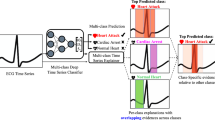Abstract
Deep learning methods have shown great success in several domains as they process a large amount of data efficiently, capable of solving difficult classification, forecast, segmentation, and other tasks. However, these networks suffer from their inexplicability that limits their applicability and trustworthiness. Although there exists work addressing this perspective, most of the existing approaches are limited to the image modality due to the intuitive and prominent concepts. Unfortunately, the patterns in the time-series domain are more complex and non-comprehensive, and an explanation for the network decision is pivotal in critical areas like medical, financial, or industry. Addressing the need for an explainable approach, we propose a novel interpretable network scheme, designed to inherently use an explicable reasoning process inspired by the human cognition without the need of additional post-hoc explainability methods. Therefore, the approach uses class-specific patches as they cover local patterns, relevant to the classification, to reveal similarities with samples of the same class. Besides, we introduce a novel loss concerning interpretability and accuracy that constraints P2ExNet to provide viable explanations of the data that include relevant patches, their position, class similarities, and comparison methods without compromising performance. An analysis of the results on eight publicly available time-series datasets reveals that P2ExNet reaches similar performance when compared to its counterparts while inherently providing understandable and traceable decisions.
Access this chapter
Tax calculation will be finalised at checkout
Purchases are for personal use only
Similar content being viewed by others
References
Alvarez-Melis, D., Jaakkola, T.S.: On the robustness of interpretability methods. arXiv preprint arXiv:1806.08049 (2018)
Angelov, P., Soares, E.: Towards explainable deep neural networks (xDNN). arXiv preprint arXiv:1912.02523 (2019)
Arras, L., Montavon, G., Müller, K.R., Samek, W.: Explaining recurrent neural network predictions in sentiment analysis. arXiv preprint arXiv:1706.07206 (2017)
Bojarski, M., et al.: Visualbackprop: efficient visualization of CNNs. arXiv preprint arXiv:1611.05418 (2016)
Brunelli, R.: Template Matching Techniques in Computer Vision: Theory and Practice. Wiley, Chichester (2009)
Chen, C., Li, O., Tao, C., Barnett, A.J., Su, J., Rudin, C.: This looks like that: deep learning for interpretable image recognition. arXiv preprint arXiv:1806.10574 (2018)
Choo, J., Liu, S.: Visual analytics for explainable deep learning. IEEE Comput. Graphics Appl. 38(4), 84–92 (2018)
Gee, A.H., Garcia-Olano, D., Ghosh, J., Paydarfar, D.: Explaining deep classification of time-series data with learned prototypes. arXiv preprint arXiv:1904.08935 (2019)
Gentner, D., Colhoun, J.: Analogical processes in human thinking and learning. In: Glatzeder, B., Goel, V., Müller, A. (eds.) Towards a Theory of Thinking, pp. 35–48. Springer, Heidelberg (2010). https://doi.org/10.1007/978-3-642-03129-8_3
Gu, J., Yang, Y., Tresp, V.: Understanding individual decisions of CNNs via contrastive backpropagation. In: Jawahar, C.V., Li, H., Mori, G., Schindler, K. (eds.) ACCV 2018. LNCS, vol. 11363, pp. 119–134. Springer, Cham (2019). https://doi.org/10.1007/978-3-030-20893-6_8
Guidoni, P.: On natural thinking. Eur. J. Sci. Educ. 7(2), 133–140 (1985)
Koh, P.W., Liang, P.: Understanding black-box predictions via influence functions. In: Proceedings of the 34th International Conference on Machine Learning, vol. 70, pp. 1885–1894. JMLR. org (2017)
Li, O., Liu, H., Chen, C., Rudin, C.: Deep learning for case-based reasoning through prototypes: a neural network that explains its predictions. In: Thirty-Second AAAI Conference on Artificial Intelligence (2018)
Lipton, Z.C.: The mythos of model interpretability. arXiv preprint arXiv:1606.03490 (2016)
Palacio, S., Folz, J., Hees, J., Raue, F., Borth, D., Dengel, A.: What do deep networks like to see? In: The IEEE Conference on Computer Vision and Pattern Recognition (CVPR), June 2018
Samek, W., Wiegand, T., Müller, K.R.: Explainable artificial intelligence: understanding, visualizing and interpreting deep learning models. arXiv preprint arXiv:1708.08296 (2017)
Schlegel, U., Arnout, H., El-Assady, M., Oelke, D., Keim, D.A.: Towards a rigorous evaluation of XAI methods on time series. arXiv preprint arXiv:1909.07082 (2019)
Selvaraju, R.R., Cogswell, M., Das, A., Vedantam, R., Parikh, D., Batra, D.: Grad-cam: visual explanations from deep networks via gradient-based localization. In: Proceedings of the IEEE International Conference on Computer Vision, pp. 618–626 (2017)
Siddiqui, S.A., Mercier, D., Dengel, A., Ahmed, S.: Tsinsight: a local-global attribution framework for interpretability in time-series data. arXiv preprint arXiv:2004.02958 (2020)
Siddiqui, S.A., Mercier, D., Munir, M., Dengel, A., Ahmed, S.: Tsviz: demystification of deep learning models for time-series analysis. IEEE Access 7, 67027–67040 (2019)
Simonyan, K., Vedaldi, A., Zisserman, A.: Deep inside convolutional networks: visualising image classification models and saliency maps. arXiv preprint arXiv:1312.6034 (2013)
Tomsett, R., Harborne, D., Chakraborty, S., Gurram, P., Preece, A.: Sanity checks for saliency metrics. arXiv preprint arXiv:1912.01451 (2019)
Yeh, C.K., Kim, J., Yen, I.E.H., Ravikumar, P.K.: Representer point selection for explaining deep neural networks. In: Advances in Neural Information Processing Systems, pp. 9291–9301 (2018)
Yosinski, J., Clune, J., Nguyen, A., Fuchs, T., Lipson, H.: Understanding neural networks through deep visualization. arXiv preprint arXiv:1506.06579 (2015)
Zhang, Q.s., Zhu, S.C.: Visual interpretability for deep learning: a survey. Front. Inf. Technol. Electron. Eng. 19(1), 27–39 (2018)
Zhang, Q., Nian Wu, Y., Zhu, S.C.: Interpretable convolutional neural networks. In: Proceedings of the IEEE Conference on Computer Vision and Pattern Recognition, pp. 8827–8836 (2018)
Zintgraf, L.M., Cohen, T.S., Adel, T., Welling, M.: Visualizing deep neural network decisions: Prediction difference analysis. arXiv preprint arXiv:1702.04595 (2017)
Acknowledgements
This work was supported by the BMBF projects DeFuseNN (Grant 01IW17002) and the ExplAINN (BMBF Grant 01IS19074). We thank all members of the Deep Learning Competence Center at the DFKI for their comments and support.
Author information
Authors and Affiliations
Corresponding author
Editor information
Editors and Affiliations
Rights and permissions
Copyright information
© 2020 Springer Nature Switzerland AG
About this paper
Cite this paper
Mercier, D., Dengel, A., Ahmed, S. (2020). P2ExNet: Patch-Based Prototype Explanation Network. In: Yang, H., Pasupa, K., Leung, A.CS., Kwok, J.T., Chan, J.H., King, I. (eds) Neural Information Processing. ICONIP 2020. Lecture Notes in Computer Science(), vol 12534. Springer, Cham. https://doi.org/10.1007/978-3-030-63836-8_27
Download citation
DOI: https://doi.org/10.1007/978-3-030-63836-8_27
Published:
Publisher Name: Springer, Cham
Print ISBN: 978-3-030-63835-1
Online ISBN: 978-3-030-63836-8
eBook Packages: Computer ScienceComputer Science (R0)




